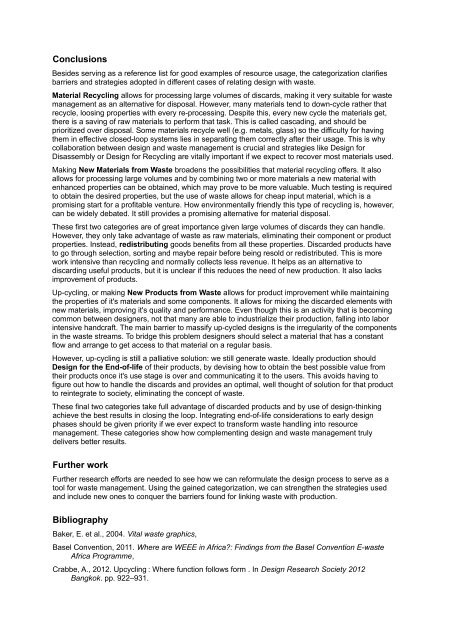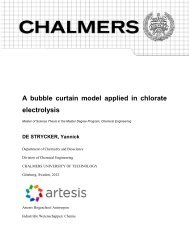How Design relates to Waste: A Categorization of Concrete Examples
How Design relates to Waste: A Categorization of Concrete Examples
How Design relates to Waste: A Categorization of Concrete Examples
Create successful ePaper yourself
Turn your PDF publications into a flip-book with our unique Google optimized e-Paper software.
Conclusions<br />
Besides serving as a reference list for good examples <strong>of</strong> resource usage, the categorization clarifies<br />
barriers and strategies adopted in different cases <strong>of</strong> relating design with waste.<br />
Material Recycling allows for processing large volumes <strong>of</strong> discards, making it very suitable for waste<br />
management as an alternative for disposal. <strong>How</strong>ever, many materials tend <strong>to</strong> down-cycle rather that<br />
recycle, loosing properties with every re-processing. Despite this, every new cycle the materials get,<br />
there is a saving <strong>of</strong> raw materials <strong>to</strong> perform that task. This is called cascading, and should be<br />
prioritized over disposal. Some materials recycle well (e.g. metals, glass) so the difficulty for having<br />
them in effective closed-loop systems lies in separating them correctly after their usage. This is why<br />
collaboration between design and waste management is crucial and strategies like <strong>Design</strong> for<br />
Disassembly or <strong>Design</strong> for Recycling are vitally important if we expect <strong>to</strong> recover most materials used.<br />
Making New Materials from <strong>Waste</strong> broadens the possibilities that material recycling <strong>of</strong>fers. It also<br />
allows for processing large volumes and by combining two or more materials a new material with<br />
enhanced properties can be obtained, which may prove <strong>to</strong> be more valuable. Much testing is required<br />
<strong>to</strong> obtain the desired properties, but the use <strong>of</strong> waste allows for cheap input material, which is a<br />
promising start for a pr<strong>of</strong>itable venture. <strong>How</strong> environmentally friendly this type <strong>of</strong> recycling is, however,<br />
can be widely debated. It still provides a promising alternative for material disposal.<br />
These first two categories are <strong>of</strong> great importance given large volumes <strong>of</strong> discards they can handle.<br />
<strong>How</strong>ever, they only take advantage <strong>of</strong> waste as raw materials, eliminating their component or product<br />
properties. Instead, redistributing goods benefits from all these properties. Discarded products have<br />
<strong>to</strong> go through selection, sorting and maybe repair before being resold or redistributed. This is more<br />
work intensive than recycling and normally collects less revenue. It helps as an alternative <strong>to</strong><br />
discarding useful products, but it is unclear if this reduces the need <strong>of</strong> new production. It also lacks<br />
improvement <strong>of</strong> products.<br />
Up-cycling, or making New Products from <strong>Waste</strong> allows for product improvement while maintaining<br />
the properties <strong>of</strong> it's materials and some components. It allows for mixing the discarded elements with<br />
new materials, improving it's quality and performance. Even though this is an activity that is becoming<br />
common between designers, not that many are able <strong>to</strong> industrialize their production, falling in<strong>to</strong> labor<br />
intensive handcraft. The main barrier <strong>to</strong> massify up-cycled designs is the irregularity <strong>of</strong> the components<br />
in the waste streams. To bridge this problem designers should select a material that has a constant<br />
flow and arrange <strong>to</strong> get access <strong>to</strong> that material on a regular basis.<br />
<strong>How</strong>ever, up-cycling is still a palliative solution: we still generate waste. Ideally production should<br />
<strong>Design</strong> for the End-<strong>of</strong>-life <strong>of</strong> their products, by devising how <strong>to</strong> obtain the best possible value from<br />
their products once it's use stage is over and communicating it <strong>to</strong> the users. This avoids having <strong>to</strong><br />
figure out how <strong>to</strong> handle the discards and provides an optimal, well thought <strong>of</strong> solution for that product<br />
<strong>to</strong> reintegrate <strong>to</strong> society, eliminating the concept <strong>of</strong> waste.<br />
These final two categories take full advantage <strong>of</strong> discarded products and by use <strong>of</strong> design-thinking<br />
achieve the best results in closing the loop. Integrating end-<strong>of</strong>-life considerations <strong>to</strong> early design<br />
phases should be given priority if we ever expect <strong>to</strong> transform waste handling in<strong>to</strong> resource<br />
management. These categories show how complementing design and waste management truly<br />
delivers better results.<br />
Further work<br />
Further research efforts are needed <strong>to</strong> see how we can reformulate the design process <strong>to</strong> serve as a<br />
<strong>to</strong>ol for waste management. Using the gained categorization, we can strengthen the strategies used<br />
and include new ones <strong>to</strong> conquer the barriers found for linking waste with production.<br />
Bibliography<br />
Baker, E. et al., 2004. Vital waste graphics,<br />
Basel Convention, 2011. Where are WEEE in Africa?: Findings from the Basel Convention E-waste<br />
Africa Programme,<br />
Crabbe, A., 2012. Upcycling : Where function follows form . In <strong>Design</strong> Research Society 2012<br />
Bangkok. pp. 922–931.















